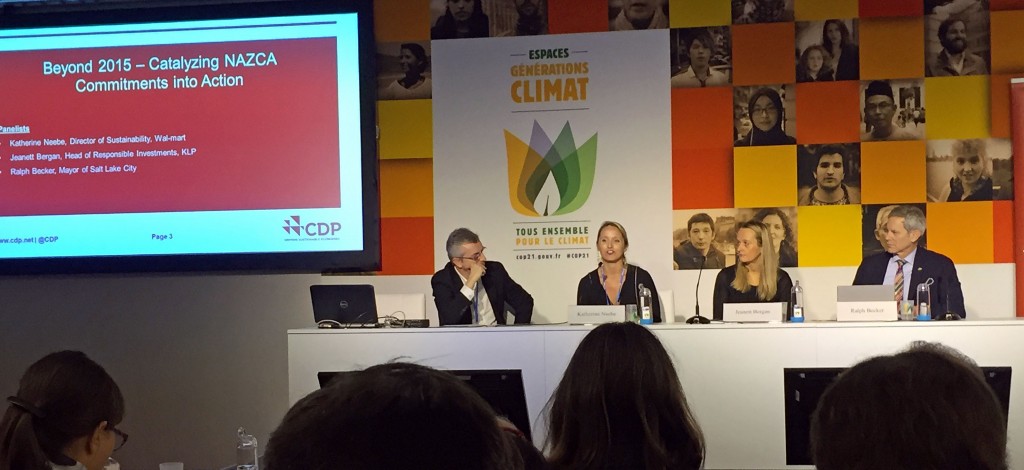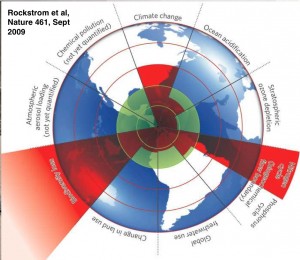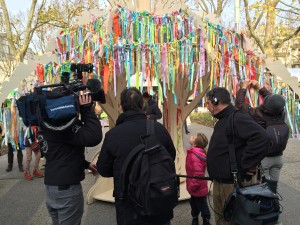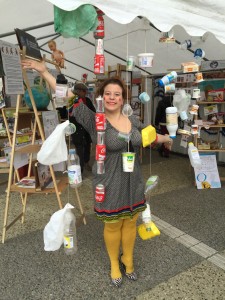Now that the conference is starting to wind down, I am trying to get the most out of every day I have left. Today I decided to spend the day back at the Climate Generations space to see a few panels that looked especially interesting. After a nice breakfast at a little cafe near Place to B (I’ve given up on the hostel breakfast), I got on the train to Le Bourget at about 10 a.m., hoping to arrive by 11 a.m. for an 11:15 panel with Christiana Figueres, executive secretary of the UNFCCC, and Laurent Fabius, French foreign minister who was functioning as president of COP 21. Since this was the first panel of the day, security lines were out the door, and I almost didn’t make it there in time.
The subject of the panel was “Beyond 2015: Transforming NAZCA Commitments into Action” – NAZCA being Non-State Actor Zone for Climate Action – in other words, city and state governments, corporations, and the like. This was the only time I had seen when Figueres and Fabius might be out of the Blue Zone. Unfortunately neither of them made it out. I’m not sure what was going on with negotiations, but apparently they were busy. Instead we heard briefly from Ségolène Royal, French minister for ecology, sustainable development and energy, and two officials from the United Nations. Then was the main part of the panel: Katherine Neebe, director of sustainability at Walmart’ Jeanett Bergan, of the Noway investment fund KLP; and Ralph Becker, mayor of Salt Lake City.
The mayor was the best of the three, declaring openly that we need a new Congress before the Senate will do what needs to be done regarding climate change. He also discussed everything Salt Lake City is doing regarding climate. Neebe said Walmart has set goals for zero emissions and zero waste, which is great – but when asked during Q and A she dodged questions on whether Walmart would commit to supporting the COP21 agreement with conservative senators and whether Walmart would commit to phasing out plastic bags. The KPL representative was equally disappointing. She said the fund has divested from coal but decided not to divest from other fossil fuels due to financial concerns. I don’t know what those could be: Research shows that 80 percent of known fossil fuel reserves must stay in the ground, which will result in a lot of stranded assets.
Once the panel got out, I needed to get lunch. Lines at the restaurants were not as long as the first day, but still long. I got into the line for crepes and waited. By the time I got my food, all tables were occupied. I ended up sitting next to a woman from a nonprofit called Population Media Center, which works on the issue of overpopulation – but has a very creative way to getting their message out. They work with the producers of TV shows, specifically soap operas and shows aimed at teenagers, to get messages about birth control and not having children into the script. Apparently this effort to lower birth rates has been done since the 1970s — and there’s lots of evidence that it works.
By the time I finished lunch, the next panel I wanted to see had already started. It was on “Keeping fossil fuels in the ground: the international movement to ban fracking,” featuring Bill McKibben of 350.org. I headed over after hearing from my CCL colleague Michael Holm on Facebook that McKibben was speaking, and managed to catch the last 10 minutes of his talk. I haven’t followed the anti-fracking movement closely, so I didn’t know most of the other panelists, but they were all good: Kassie Siegel, Center for Biological Diversity; John Fenton, farmer from Wyoming; Sandra Steingraber, New York biologist who writes about fracking; Wenonah Hauter, Food and Water Watch; Liesbeth von Tongeren, Greenpeace Netherlands; and Joaquin Turco, fracking activist from Argentina.
After the panel was a 3 p.m. protest against fracking near the columns outside the main venue for COP 21. Rally organizers had managed to get a 30-minute permit for the event from the French government, and the rally took place under the watchful eye of the police. Speakers included several people from the indigenous community, including Kandi Mossett of Indigenous Environmental Network, and Casey Camp Horinek of Global Alliance for the Rights of Nature. There were also speakers from the Netherlands, Scotland, and Argentina, and for the first time I realized that the movement against fracking is truly global. The rally ended with a beautiful women’s warrior song led by Horinek.
Once the rally dispersed, I found the Sierra Club table in Climate Generations and traded stories of the panels I had been to with people there. Steven Sondheim had gone to a panel that touted nuclear power as the solution to climate change. This is a matter of hot debate among climate activists. James Hansen and three colleagues say nuclear power is essential to transitioning off fossil fuels because it provides a lot of energy with no carbon emissions. Others point out that nuclear plants take a long time to site and build, partly because no one wants to live near them; that while accidents are unlikely, they can be catastrophic; and that no one wants to accept the radioactive waste which must be stored forever. The Sierra Club and most environmental organizations have long been anti-nuclear. Citizens Climate Lobby does not take a position.
At the Sierra Club booth I also met another national board member, Michael Dorsey, who teaches environmental policy at Dartmouth. Michael told me has been “going to COPs since before they were COPs,” and has made climate justice a central part of his research. Michael, Larry Fahn, and I were all headed to the same evening event, so we took the train together to Gare du Nord, then caught a cab to the event: a legal panel on “What Exxon Knew and What It Did Anyway,” discussing the prospects of a RICO case against Exxon and other fossil fuel corporations similar to the case brought by the Department of Justice against the tobacco industry.
I was not allowed to videotape the event, probably because the attorneys who presented understandably do not want details to get out to the opposition. But I can post some basic information. The event was introduced by Antonio Oposa, an environmental lawyer from the Philippines who has won several landmark cases to protect topical forests and clean up Manila Bay. Then U.S. environmental attorney Matthew Pawa presented a case against Exxon for violations of the RICO statutes based on documents that have recently been made public through blockbuster reporting by Inside Climate News and Los Angeles Times. Pawa has already won cases against Exxon over groundwater pollution in New Hampshire, and against AEP over greenhouse gas pollution. Finally a panel of experts responded to the case and took questions from the audience. These included Naomi Ages of Greenpeace; Richard Harvey, British human rights attorney; Ken Kimmel of Union of Concerned Scientists; Michael Gerrard, director of the Sabin Center for Climate Change Law at the Earth Institute, Columbia University; and Carroll Muffett, president of the Center for International Environmental Law, which organized the event.
Having missed a similar event with Naomi Klein and Bill McKibben on Saturday — Bill McKibben was in the audience for this — I was especially glad to catch this event, which featured some of the very people who will likely be involved in an actual case against Exxon if it ever goes to trial. But by the time the event got out, I was past ready for dinner. I walked back to Place to B with the idea of dropping off my heavy backpack, then finding a nearby restaurant. However, upon arrival, I was beckoned into the bar area and offered a free vegan dinner. I don’t know which group was responsible, but there was a huge spread of vegan food, and it was all free.
I gratefully accepted, filled a plate, and headed to the back room for a seat. As soon as I opened the door, I ran into Steven Sondheim, the Sierra Club volunteer from Tennessee, who invited me to join his table. I felt as if I had run into an old friend and was happy to find a place. One of Steven’s tablemates was an anti-fracking activist from Scotland named Maria Montinaro, and we talked for a long time. She told me that she had previously held a low-level job at the Bank of Scotland but had been fired for her fracking activism. Although there is an official moratorium on fracking in Scotland, the government is allowing test drilling ro be conducted near major cities, which has led to a series of protests and resistance actions among citizens. The government is supposed to decide in 2017 whether to lift the moratorium or make it a full ban.
As the evening wound down, we all agreed to meet up again Thursday night for a showing of Groundswell Rising at Generator Hostel. Naomi Klein would be speaking at the same time, but the plan was to show the movie once, then hold a discussion, then show it again for those at the Klein event. With that I wished everyone good night and headed to bed.












